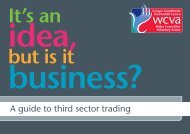Measuring Impact - Nicva
Measuring Impact - Nicva
Measuring Impact - Nicva
Create successful ePaper yourself
Turn your PDF publications into a flip-book with our unique Google optimized e-Paper software.
Lessons learnt & guidance for future work 59<br />
8.3.4 The use of visual techniques: systems mapping<br />
Visual or interactive techniques incorporated into an interview can change the whole feel of<br />
the interview. Incorporating something visual into an interview like a diagram or a map can<br />
draw attention away from the interviewer, making the interviewee feel more relaxed. It may<br />
also prove useful as something to refer to throughout the interview. Asking the interviewee to<br />
draw a diagram can be a good way of seeing how different people have different perceptions<br />
of the same thing. It can also prove a useful tool for identifying potential interviewees.<br />
We found that the technique of mapping the different agencies in a system, and the relationships<br />
between them, was a particularly useful tool throughout the assessment process. The<br />
map suggested a logical interdependency between organisations/activities that helped interviewees<br />
understand where impact might occur, while introducing notions of collective impact. It<br />
also enabled interviewees to see how their organisation related to other key players and think<br />
about their role in relation to other groups or organisations. This was important, as a key<br />
characteristic of impact for some organisations is how they provide a service differently to<br />
other agencies. The main drawback of using a system map is that it can be complex to<br />
produce, especially for organisations engaged in a wide range of activities in partnerships.<br />
The other main disadvantage is that there is a danger that it can become ‘egocentric’ – by<br />
leading to the assumption that any social or economic change can be traced back to the<br />
actions of the organisation at the centre of the map.<br />
8.3.5 Users as research assistants<br />
We assumed that the use of service users as research assistants would be a good way to<br />
involve the user communities in the research process. It was hoped this would create trust<br />
with other service users and ensure a sensitivity to any difficult issues. However, we were<br />
concerned that the quality of information would be variable, and that there would be issues<br />
around service-user confidentiality. In practice the research assistants added both depth and<br />
breadth to the research findings. They were also more able to pick up on interviewees’ fears<br />
and concerns, while differences in background enabled them to draw very different conclusions<br />
to those we may have drawn.<br />
8.3.6 Using interviews to develop indicators<br />
Two of the studies aimed to develop indicators, or at the very least themes, which could form<br />
the basis of voluntary organisations’ impact measurement. It is clear that the kind of indicators<br />
developed need to be able to capture the dynamic aspects of impact, which suggests the<br />
use of context-specific indicators. Rather than finding out whether an organisation meets<br />
these needs better than another organisation, a contextual indicator could aim to measure the<br />
extent to which a particular organisation meets needs not met by other services. Contextual<br />
indicators could assess impact by isolating the role that an organisation plays in meeting a<br />
need specified by the beneficiary group itself. These indicators can then be used by an organisation<br />
to more closely realign its aims and objectives with the actual impact identified by the<br />
service users. However, since such an approach would vastly stretch the resources of any one<br />
organisation, one option might be to encourage organisations to get together with other<br />
organisations with which they are in partnership to carry out a joint impact assessment.












